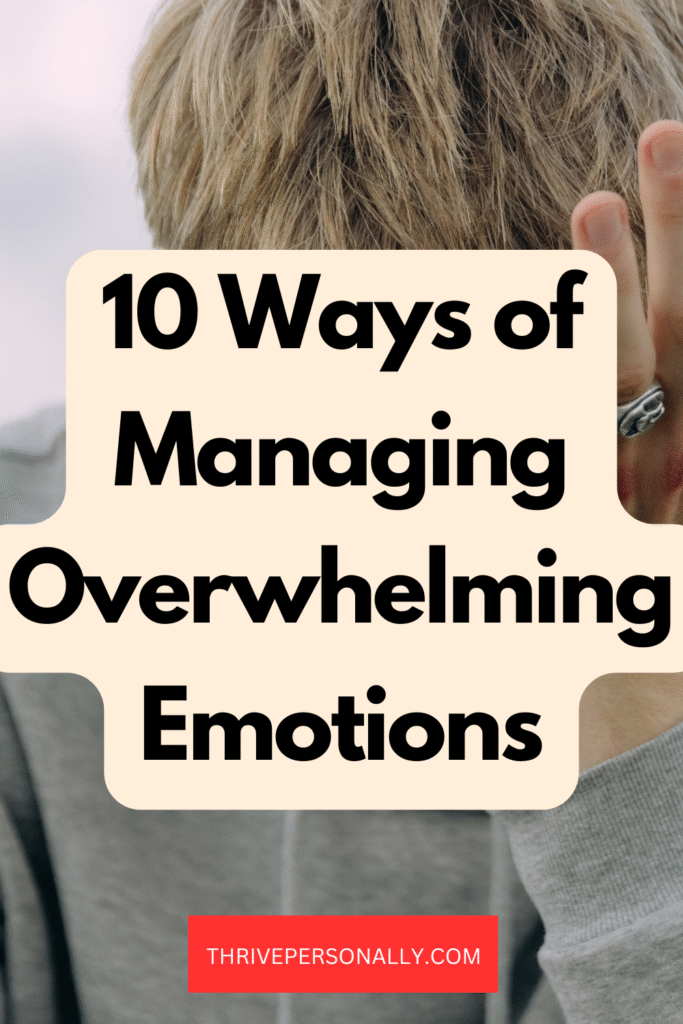All people experience times when feelings become overwhelming. It might be sadness that won’t go away, anger that bursts out too quickly, fear that locks you in place, or stress that makes it hard to breathe. These are strong emotions. They often show up when life feels like too much—when you’re in pain, afraid, confused, or just worn out.
These emotions are not bad. They are natural and common to everyone. But when they grow too strong, they can take over your mind, your actions, and even your body. You may begin to act in harmful ways—lashing out, shutting down, or freezing. That’s why learning how to handle powerful emotions is so important.
Managing emotions does not mean hiding them or pretending you’re okay. It means being aware of what you feel, knowing where it’s coming from, and handling it in a healthy way. This is a skill anyone can build. The more you practice, the easier it becomes to stay calm, think clearly, and stay grounded even when life is difficult.
10 Ways of Managing Overwhelming Emotions
1. Pause and Breathe
When emotions flood your body, the first thing to do is stop and breathe. You don’t have to fix anything right away. Just create space between the feeling and your reaction.
Deep breathing sends your brain a message: You’re safe. It helps your body slow down. Emotions like anger, anxiety, or sadness can make your heart race and muscles tighten. Breathing slowly and deeply brings calm.
Breathe in through your nose, hold for a few seconds, and exhale slowly through your mouth. Do this a few times until your mind feels more at ease. This small act helps you respond with intention, not just react.
According to a study from the University of Michigan, deep breathing can lower the intensity of strong emotions and reduce the effects of stress on the body.
Read also: 15 Essential Steps to Start Your Healing Journey
2. Feel and Name the Emotion
When emotions feel heavy, naming what you feel helps you take back control. Ask yourself: What am I feeling? It might be sadness, fear, shame, frustration, or something else.
Labeling the emotion helps you understand it better. It’s like knowing what kind of weather you’re in, instead of being lost in the storm. This awareness is often the first step in handling it well.
You can say the feeling out loud, write it down, or just think it. The goal is to make it something you can work with, instead of something that controls you.
Research from UCLA shows that naming emotions calms the brain’s fear center and helps you think more clearly.
Read also: How to Reinvent Yourself Internally and Externally
3. Let Yourself Feel Without Resistance
Sometimes, emotions feel heavier when you fight them or tell yourself don’t feel this. But feelings don’t go away just because you ignore them. They need room to be felt.
Allowing yourself to feel doesn’t mean losing control. It means letting the feeling rise, noticing it, and being aware that it’s there. No judgment. No pushing it away.
Tell yourself: It’s okay to feel this. Emotions pass more easily when you accept them instead of fearing or hiding them.
When you treat yourself kindly during these moments, you build safety inside your body. This helps you move through the emotion instead of being stuck in it.
Read also: 12 Simple Guidelines to Make Your Life Better
4. Talk to Someone You Trust
Bottling up deep feelings makes them heavier. Talking to someone you trust can bring relief. You don’t need advice—you just need to be heard.
Sharing your thoughts helps you sort them out. It also reminds you that you’re not alone. Others may not fix the pain, but they can help you carry it.
Reach out to a friend, family member, or counselor—someone who listens without judgment. Saying how you feel out loud loosens the grip of emotion on your mind.
The National Institute of Mental Health notes that social support plays a big role in mental well-being, especially during intense emotional times.
5. Move Your Body with Gentle Activity
Strong feelings live in the body as much as in the mind. Your body may feel tense, tired, or filled with nervous energy. Gentle movement can help ease this tension.
You don’t have to do anything hard. Even walking, dancing, stretching, or simple exercise can help your body release the emotions it’s holding.
Physical movement helps your brain release chemicals that bring calm and focus. It also gives you something active to do when you feel stuck.
Choose movement that feels right for your body. This helps the emotion move through you instead of staying trapped inside.
6. Write Out What You Feel
Sometimes your thoughts feel like a storm. Writing them down can help calm the chaos. When you put feelings on paper, you begin to see what’s really going on inside.
You don’t need to write well or use perfect grammar. Just let your thoughts flow. Be honest. Follow your own mind.
Writing helps clarify emotions and gives you a private place to express yourself. Doing it regularly can help you spot patterns, ease stress, and understand what your emotions are trying to tell you.
7. Come Back to the Present
Overwhelming emotions are often tied to thoughts about the past or future. You might be worrying about what’s coming or dwelling on what’s already happened.
To stay grounded, bring yourself back to the now. Ask: What is happening right now? Notice what you can see, hear, feel, or touch.
Focusing on the present pulls your mind away from endless thinking. It reconnects you to your body and your surroundings.
Even simple acts—like washing your hands, sipping water, or noticing your breath—can remind you to be present.
Mindfulness doesn’t mean being perfectly calm. It means paying attention to what’s happening and how it feels, without being swept away by it.
8. Do Something Comforting
When emotions are intense, you may feel like nothing can soothe you. But small, comforting actions can help your body feel safe again.
Think about what usually calms you—maybe soft music, drinking tea, lying down, or taking a warm shower. These tiny rituals show your body you are cared for.
Comfort is not about avoiding your feelings. It’s about supporting yourself through them. Be as kind to yourself as you would to someone you love.
You can create little calming habits to help you move through emotional storms more gently.
9. Remind Yourself That Feelings Pass
When you’re caught in a strong emotion, it may feel like it will never end. But no emotion is permanent. Feelings rise, peak, and fade—just like waves.
Sometimes, the best thing to do is wait for the wave to pass. Remind yourself: This won’t last forever. That truth makes it easier to stay balanced.
Tell yourself: It’s just a feeling. It will pass.
Learning to move through your emotions—rather than fear or fight them—is one of the strongest things you can do.
10. Look for the Message in the Emotion
Every emotion has something to tell you—even the hard ones. Sadness might be telling you to rest. Anger might point to a boundary that’s been crossed. Fear might be alerting you to something important.
Instead of pushing emotions away, try asking: What is this feeling trying to show me? This changes how you relate to your inner world.
The more you learn from your emotions, the more self-aware and resilient you become.
Every time you face a strong feeling and choose to learn from it, you build emotional strength. That strength helps carry you through future storms.
Final Thoughts
Overwhelming emotions are part of life. They show up when things feel too hard, too uncertain, or too painful. But these emotions are not your enemy—they are signals from within.
The goal isn’t to stop feeling. It’s to feel with clarity, care, and calm. When you pause, breathe, name what you feel, and take supportive actions, you gain power over your emotions instead of letting them control you.
You have more strength than you think. Your emotions may be loud, but they don’t have to take the lead. With practice, you can learn to stay steady even when you feel big things.
Save the pin for later



